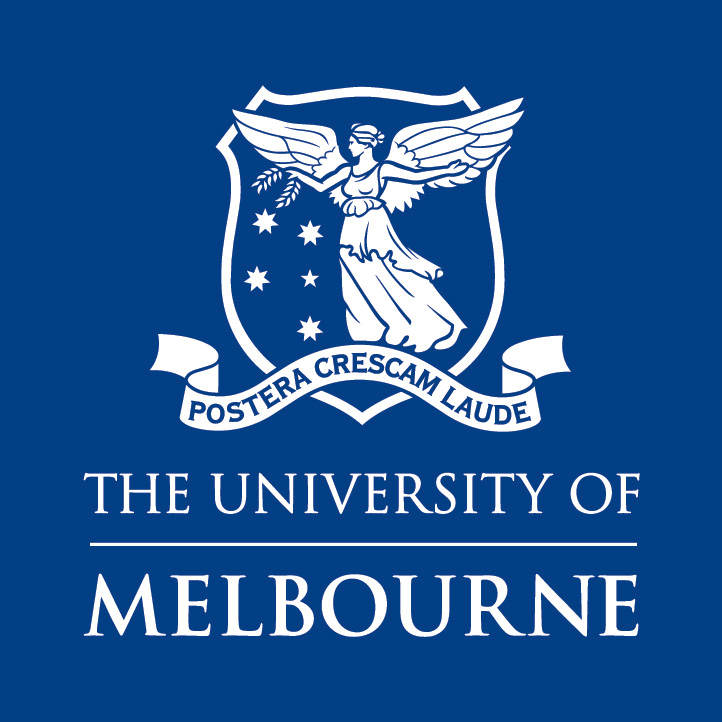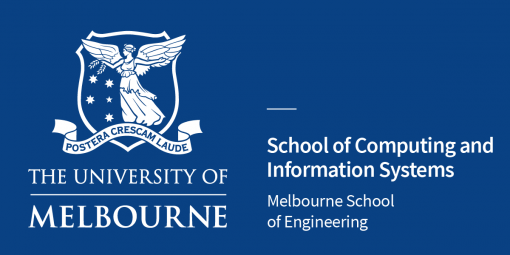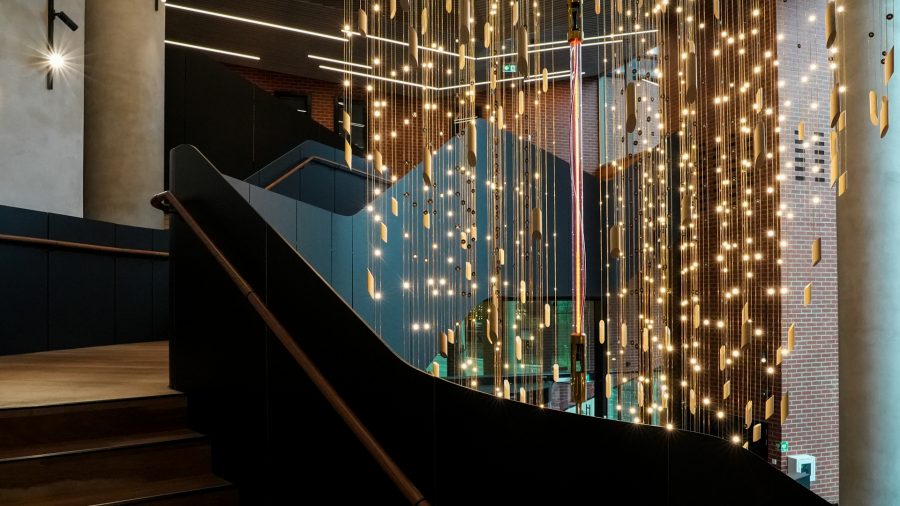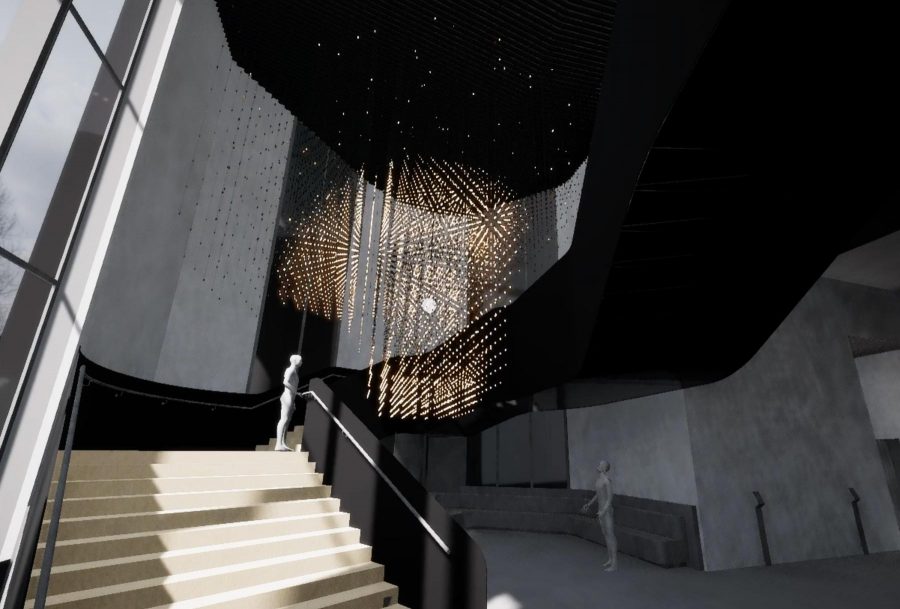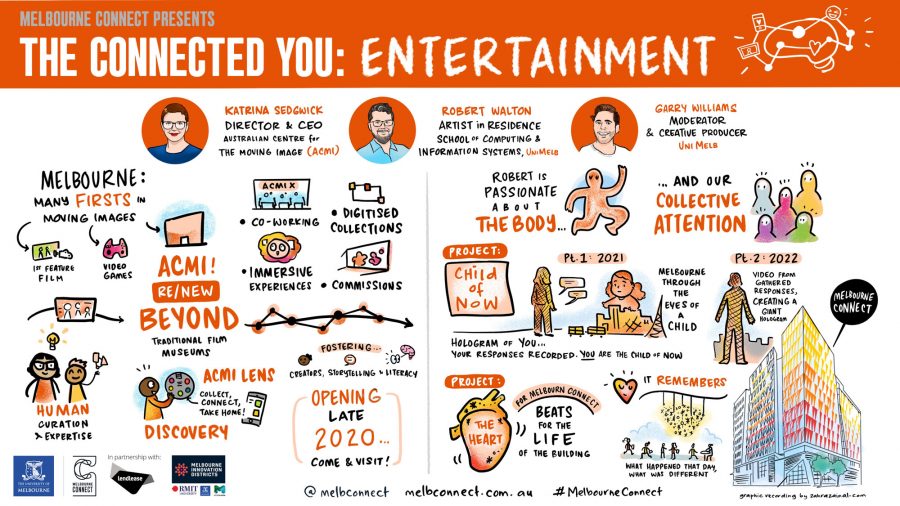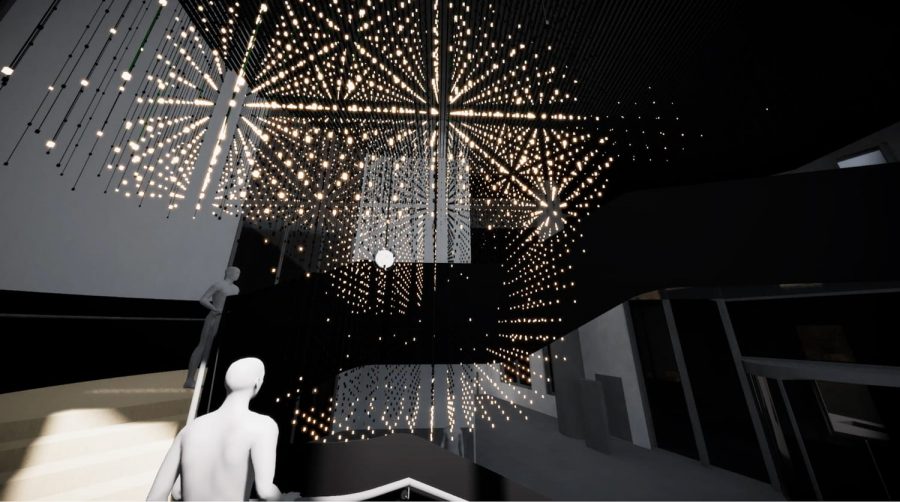The Heart
Can a building have a heart?
The Heart is a site-responsive, slow Artificial Intelligence performance artwork to be lived with over decades. It reveals the pulse of a superorganism: the community visiting, living, and working in Melbourne Connect, a city-block size building, home of businesses, university departments, a kindergarten, accommodation, and a science museum. The Heart beats indefinitely for and with the life of the building and its community.
The Heart is connected to 4800 ‘Building Information Modelling’ (BIM) sensors. These monitor CO2, humidity, room occupancy, temperature, movement, light, and more. The building adjusts the environment to create the optimum conditions for human comfort and safety. Normally, the automated work of building sensors and systems is dispersed and imperceptible. The Heart stages the building’s ‘sensations’ in a way people can perceive and begin to empathise with. It does this by taking form in the foyer of Melbourne Connect as a 10-metre-tall volume of brass droppers, reconstituted brick fragments, and LEDs in the shape of a giant human heart.
Monument and Memory
The Heart was inspired by the former use of the site as the Royal Women’s Hospital where hundreds of thousands of hearts began to beat independently of their mothers. Reconstituted bricks from the hospital are incorporated into the outline of the human heart in the artwork.
The Heart is a monument to the many thousands of people who gave their hearts to the University of Melbourne for medical research. The creative team spent time learning about heart anatomy with the collection of plasticised hearts in the University’s anatomy museum. The giant heart in the artwork is dedicated to anonymous donors and their families. It was developed through a ‘ghost-heart’ concept that projects a virtual heart into the void and samples its surface at the points where vertical droppers intersect with it. Two pieces of reconstituted brick from the Royal Women’s Hospital mark the top and bottom of each dropper. Collectively these form the outline of the anonymous heart in the work.
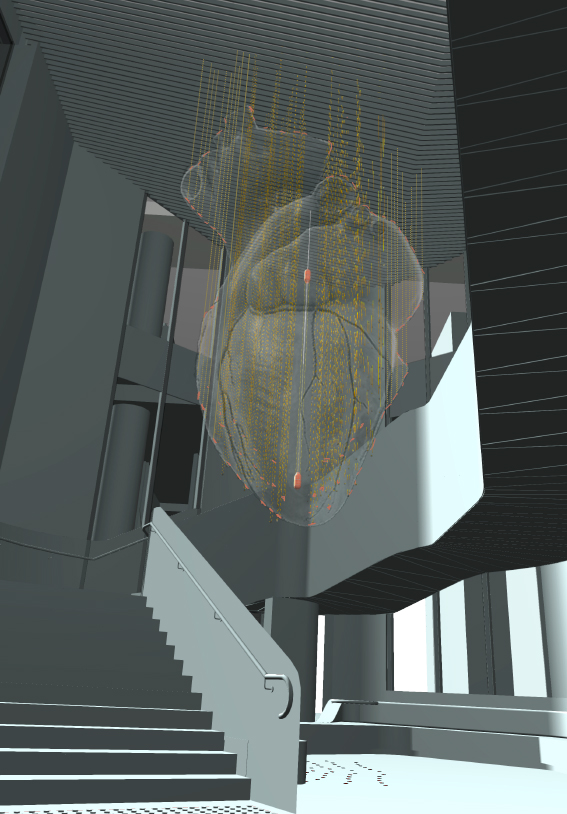
Elements
The Heart is a ‘full stack’ work that incorporates custom hardware and software elements built from the ground up.
Neon Heart Node
The central node of the artwork is a custom tapered, vertical neon tube that functions dynamically to animate the pulse of the building in bright red light. In contrast to the LED lights in the work, this ephemeral gaseous light is The Heart’s equivalent of an ‘eternal flame’ that will pulse indefinitely. This brass, glass, and neon centrepiece includes a 2.5-metre section of self-suspended glass that bears the weight of more brass and a brick element below it.
Heart Array
The Heart Array consists of thousands of bespoke LED light fittings within the volume of the ‘ghost-heart’ outline. It is made of 1.5 km of brass rods in 142 droppers supporting 1450 printed circuit boards (PCBs), 10,000 white LEDs, and 284 cores in the outline of a human heart made with bricks from the Royal Woman’s Hospital. The Heart Array is effectively a ‘volumetric screen’ that can display moving 3D forms. Each PCB is laser inscribed with song lines that inspired the project.
Heart Sensor
The installation includes a brass heart rate monitor that visitors can touch to interface with The Heart directly. The sensor emits a red light the same colour as the neon which illuminates the finger that touches it. When a heart rate is detected, it melds with the pulse of the building in The Heart’s animation.
Lighting Control, Computers, Network, Sensors and Cloud Computing
The artwork connects to 4800 sensors distributed around the building and appropriates their data. This is processed by cloud computing resources that funnels information to a local computer that in turn directs the lighting control hardware. As The Heart is sensitive to the people living in the building (their movement, location, respiration etc.) it might be thought of as temporarily appropriating them within the artwork.
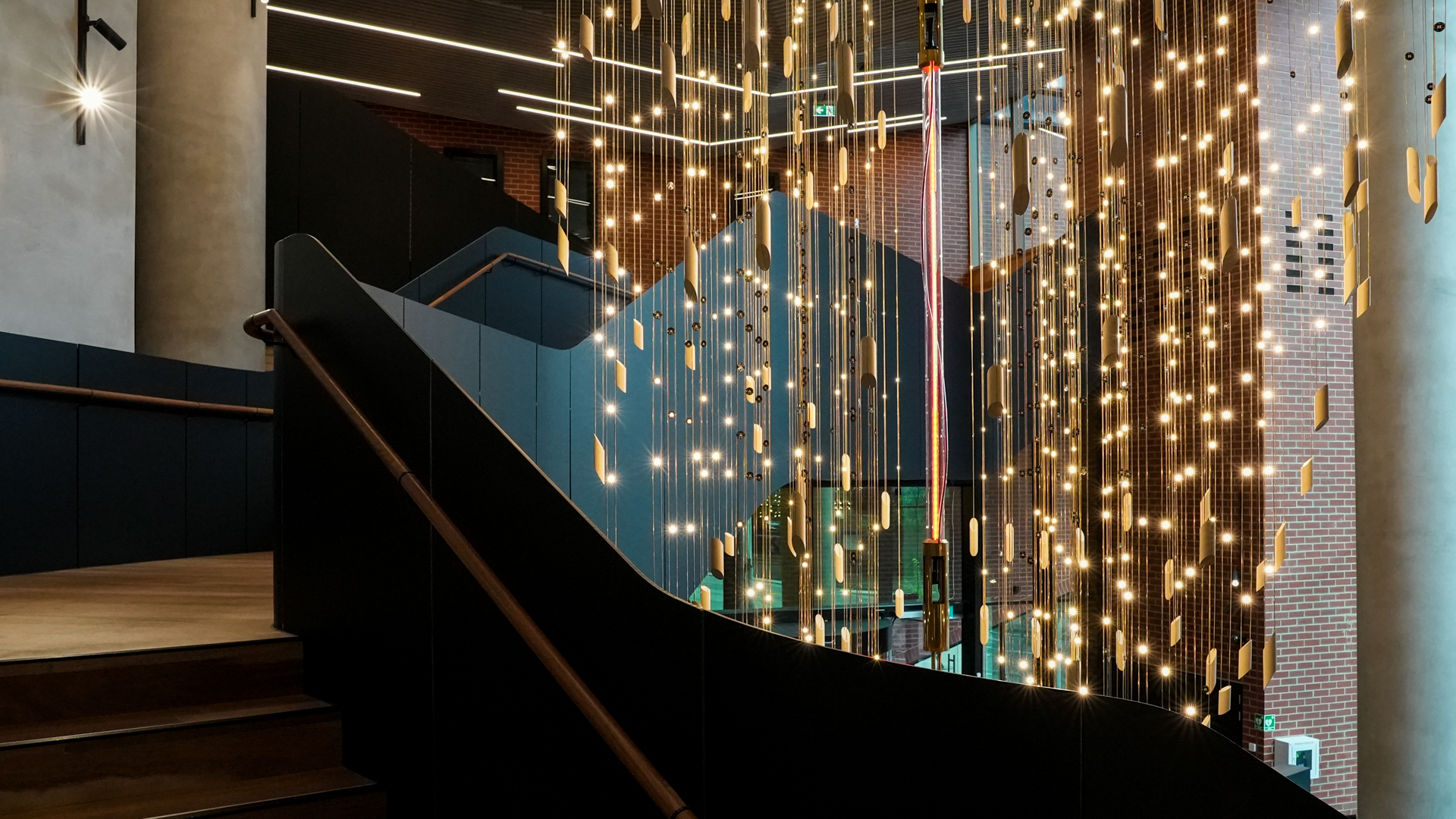
Artificial Intelligence
Manifold Learning
The Heart uses Manifold Learning to become accustomed to the live ‘sensations’ it receives from its ‘body’ (the building) over the course of each day. At night when The Heart sleeps, it creates a new manifold merged with previous days’ manifolds. When awake, it compares what it ‘feels’ in the present against its habituated experience of the past. If current ‘sensations’ fall outside of the manifold it experiences surprise and increases its pulse.
Generative Adversarial Network
The Heart also uses a Generative Adversarial Network (GAN) to develop a capacity to anticipate what it is about to ‘feel’ based on its ‘lifetime’ of habituated experiences. This ability increases slowly as The Heart ages and the GAN is trained over years. In this way, The Heart matures as a longform ambient artwork and experiment that grows with the community over decades. It is a provocation to work with heart and attune to the non-verbal, sensate environment our lives are bound up within and not separate from.
Date
December 2019: Conception
February 2022: AI Training Begins
December 2022: Heartbeat Starts
4 April 2023: Launched
Location
Melbourne Connect, 700 Swanston Street, Melbourne
Project Team
Concept, Lead Artist
Robert Walton
Design – Heart Array and Heart Node Hardware
Paul Lim and Bosco Shaw, ADDITIVE
AI/ML Lead – The Heart Beats
Zaher Joukhadar Melbourne Data Analytics Program
Unity Development – The Heart Digital Twin
Brad Hammond EXP
Technical Consultant
Gendry Morales
Project Officers
Lindsay Bick, Loi Tai, Matthew Driver, Luke Sutton Melbourne Connect
Heart Array Fabrication
Casey Loraine Showtools International
Heart Node and Sensor Housing Fabrication
Callan Morgan Pelican Studios
Builders
Adrian Brown Jointly
Neon Wrangling
Karl Gordon Australian Neon Services
Scientific Glass Blowing
Mark Chandler Platinum Laboratory Services
Heart Monitors
Jeremiah Rose
Videography and Photography
Michael McAtomney
Melbourne Data Analytics Platform
Dr. Aleks Michalewicz – Research Data Specialist
Aidan McLoughney – PhD Candidate and MDAP intern.
Bobbie Shaban- Senior Research Data Specialist
Commission Competition Team
Dr Robert Walton, Resident Artist, Computing and Information Systems
Zaher Joukhadar, Research Data Specialist
Henrietta Lyons, Interaction Design Lab Graduate Researcher
Dr Eduardo Velloso, Senior Lecturer and Researcher, Computing and Information Systems
University of Melbourne Experts
Dr Rackel San Nicolas – Infrastructure Engineering – Advisor on recycling bricks from Royal Women’s Hospital
A/Prof Charles Sevigny – Anatomy and Physiology – Advisor on human heart anatomy and behaviour
Consultants
Justin Green, consultant artist
Katie Sfetkedis, consultant artist
Brad Quirk, Data Scientist
Alaistair Flynn, Senior Assoicate, WoodsBaggot
Hazel Porter, Principal, WoodsBaggot
Alastair Cossart, Senior Structural Engineer, ARUP
Category
Installation, Durational Performance, Emerging Technology, Artificial Intelligence, Lighting, Neon, Brass, Sensors, Concrete, Digital Twin, Building Data
Created for
